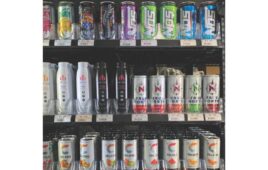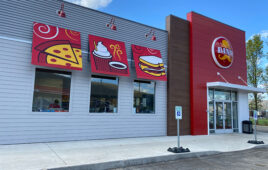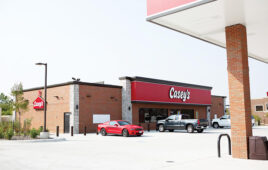Convenience categories are evolving quickly. This year, CSD highlights the
latest movers and profitable moneymakers.
A CSD Staff Report
If there is one word that perhaps best describes most convenience categories in 2019 it might be innovation.
We’re talking innovation on the part of fast-moving consumer product manufacturers and innovation on the part of convenience retailers looking to separate themselves from the competition.
Over the past year, to capture consumers’ ever-fluctuating preferences, more c-stores began offering store-made pizza, bean-to-cup coffees, locally-sourced proteins, delectable smoothies and fresh fruits and vegetables.
In terms of category merchandise, there was much for category managers to decipher, from vitamin waters to fruit-infused carbonated drinks to M&M’s chocolate bars.
Such diversity reflects the changing tastes of a U.S. consumer base that is widening when it comes to the number of customers that frequent the neighborhood c-store.
An average convenience store selling fuel has around 1,100 customers per day, or more than 400,000 per year, according to the National Association of Convenience Stores (NACS). Cumulatively, the U.S. convenience store industry alone serves nearly 165 million customers per day, and 58 billion customers every year.
That’s a lot of customer preferences to track. Some categories are being dramatically impacted.
BEVERAGES REFRESH
Brands wield more power in non-alcoholic beverages than almost any other product category, fueled by consumer loyalty and operator priorities in customer-facing coolers and self-serve fountains or dispensers, according to Datassential’s latest Non-Alcoholic Beverage Keynote from October 2018.
Brand preference is the top driver of retail sales of soda, juice, energy and sports drinks, and is even a factor for 60% of bottled water buyers. About half of operators say brand is important in customers’ purchases of packaged water, juice and iced tea, and three-quarters say so for soda.
TOBACCO EVOLVES
In 2018, Juul almost single-handedly rejuvenated a lagging e-cigarette segment.
With the decline of cigarette sales, Big Tobacco is investing more time and resources to growing its next-generation products in response to the waning demand for traditional combustible products like cigarettes. And the success stories that major tobacco manufacturers aren’t writing, they are collaborating on.
The biggest headlines appeared in this past December with tobacco giant Altria investing $12.8 billion in Juul, taking a 35% stake in the e-cigarette maker.
TECHNOLOGY ABOUNDS
According to estimates from Grand View Research, the Internet of Things (IoT) at retail could be a $94 billion market by 2025. The impact of IoT is already undeniable, helping c-stores modernize their operations, better manage inventory, reduce shrinkage and hone their supply chain efficiencies.
IoT is just one part of the scenario as convenience stores are implementing new means to interact with consumers on social media, employing beacon technology to harness data and upgrading point-of-sale systems to accommodate the rapid move to a mobile-wallet economy.
FUEL FOR THOUGHT
Ethanol-blended fuel is slowly making in-roads into the c-store channel, though market forces and issues prompted by government oversight have combined to slow adoption of E15. According to John Eichberger, executive director of the Fuels Institute, E85 fuel faces its own uncertain future.
“In terms of E85, there is no incentive remaining for automobile manufacturers to produce flex fuel vehicles. The CAFE credit they used to receive has expired and most forecasts I have seen expect production to reach minimal levels within the next five years or so,” Eichberger said. “We have seen an expansion in the number of E85 outlets, but I suspect this is largely due to the need to have E85 in order to offer E15.”
Aside from ethanol blends, biodiesel and other offerings, more c-stores are also adding electric vehicle charging stations.
ALTERNATIVE MEASURES
As an increasing number of states legalize the use of marijuana, a product known as CBD oil has surged in popularity. This past December, CNN dubbed CBD “USA’s coolest food and drink ingredient.”
According to Vaping360, CBD oil alone is already a $340 million market, and sales of the compound, in all of its diverse forms, are on the rise.
A new whitepaper from Euromonitor International assesses how the inevitability of recreational legalization of marijuana is set to shake up fast-moving consumer products, including beverages, food, health and beauty, and tobacco, among other categories. Among some observations:
• Alcohol: Currently, alcohol has added the most products in the CBD/cannabis sector, so a future where CBD-based products replace alcohol by volume may be on the horizon, according to industry observers.
• Tobacco: By 2030, the vaping of cannabis alongside consumption in other formats will have “irrevocably” framed the expectations of consumers with respect to the delivery of nicotine.
• Soft drinks: In the short-term, the main opportunity for cannabis within soft drinks will be CBD-infused beverages.
• Packaged food: Global sales of packaged food with CBD are expected to double over the next two years.
• Beauty: Skin care is expected to be a main driver.
• Consumer health: Vitamins and dietary supplements are predicted to be the largest cannabis-related category in consumer health by 2025.
There’s more on the horizon for c-store categories. Check out our March issue, where CSD provides a snapshot of the trending topics affecting each one as 2019 rolls on.




